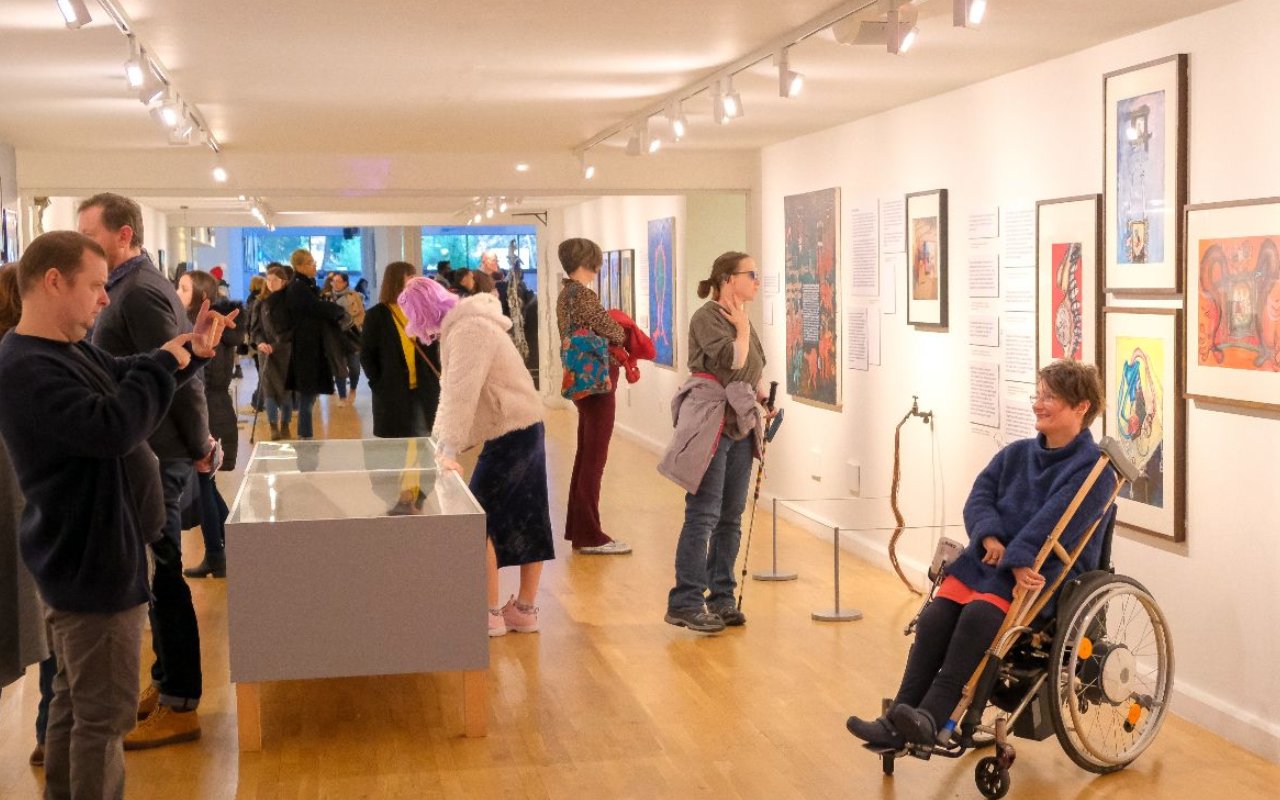
Exhibition and showcase by Anna Berry at MAC Birmingham
Photo: Kate Green
Curators of the future
Being disabled in the visual arts sector has presented galleries with serious challenges. But Mike Layward is optimistic about programmes which promote much needed change.
There is an anarchist saying – ‘we don’t want the crumbs from the loaf, we want the bakery’. So how do we as a sector implement real change around diversity so it is not just breadcrumbs but deeper structural change?
For decades this conversation has been discussed, dissected, consulted, implemented, started, stopped, swept under the carpet and then rediscovered after a few years and started again. This stop/start process has particularly frustrated diverse artists and activists and has left a bitter taste that deep change will never happen, will be tokenistic or will not happen in our lifetimes.
Back to the beginning
DASH (Disability Arts in Shropshire) was formed in the 1990s and became a Disabled-led charity and Limited Company in 2001, with most of its staff and board self-defining as disabled. The social model of Disability drives our aims and vision.
Provocations such as the Awkward Bastards series and live art events like M21 have been at the core of DASH’s mix of art, humour and activism. And our latest award-winning work ‘we are Invisible we are visible’ will involve some 50 interventions in galleries across the UK in 2022, in a 21st century version of Dada.
Over the past decade DASH has been looking at how small Disabled-led visual arts organisations (fewer than 4 full time employees) can adopt practical measures to bring about long-term change in the visual arts sector.
How to achieve the change
The answers we have found are obvious and not original. In the long term, we need to go beyond three-year cycles, which raise expectations only to dash them when the programmes come to an end.
Diverse-led arts organisations are predominantly small and overworked, producing disproportionately more than their size would suggest. In order to achieve the change we want, we need to build partnerships and networks to magnify the impact and build trust between allies.
And for significant change to take place, we need equality and diversity in our leadership to bring perspectives that actively consider Disability art as part of the visual arts canon, taking its place alongside Black art, Feminist art and Queer art.
The Future Curators Programme (FCP)
The FCP originated in 2018 as a practical development programme which placed Disabled curators and/or artists as residents within galleries for a year. Since then, a distinct buzz around the engagement and training of Disabled curators in the UK has been growing, making this programme relevant and realistic.
This hasn’t always been the case, as Disabled curator Aidan Moesby knows only too well: “Of all the curators I wrote to inviting a conversation, not one in the UK acknowledged my e-mail. In stark contrast, I managed to meet directors of galleries, museums and national organisations in Denmark, Sweden and Finland. It wasn’t until I studied for my MA Curating that I actually got to talk to curators in the UK…”
DASH has been working with galleries in England and Wales since 2009 creating opportunities for Disabled artists to exhibit and curate. These opportunities have significantly advanced the careers of fifteen Disabled artists to date, but the influence of these commissions on the commissioning galleries has not been long lasting. Once the artist’s show had finished, the impact was lost. Hence the need for the FCP.
Developing practical understanding
We began working with three galleries: MAC Birmingham, MIMA Middlesbrough and Wysing Art Centre. These three supported a diverse network in scale, style and geography.
The starting point and the premise was to develop a number of skilled Disabled curators who would be able to influence the sector. And the aim was to change the host institutions by helping them develop a practical understanding of how to employ a Disabled person as part of their team.
John Bloomfield, curator and acting Head of Programme at Wysing Arts Centre, reflects: “This programme has already had an enormous effect on our organisation. We see this work as a key part of our Mission Statement – we’re interested in what art can do for all kinds of people – and it has made us look at all our structures and procedures to ensure that they work for everyone.
“We recognise that there’s more to learn to ensure our work is accessible, so it was important for us to work in partnership with experts like DASH in order to make meaningful change.”
Hannah Wallis, FCP curator at Wysing comments: “We’re all learning how to be different with each other, and being asked what you need is key… It took me years to accept the realities of my disability, and what is interesting about this residency is that it’s brought me into this conversation in a new way, whereby I have the opportunity to effect change in a much more direct way.”
What happens now?
We hope this change in leadership attitudes will encourage and foster new audiences in these institutions where diverse people will see themselves in the work being shown.
This critical engagement from a curatorial perspective, fostered within arts organisations, is a direct development of our partnership work, allowing galleries across the UK to learn from each other’s experiences.
We are now actively recruiting three new galleries for the next round of the FCP, which will be announced this autumn, broadening the network and its influence over the next five years. It’s an exciting prospect.
Mike Layward is Director of DASH
Join the Discussion
You must be logged in to post a comment.